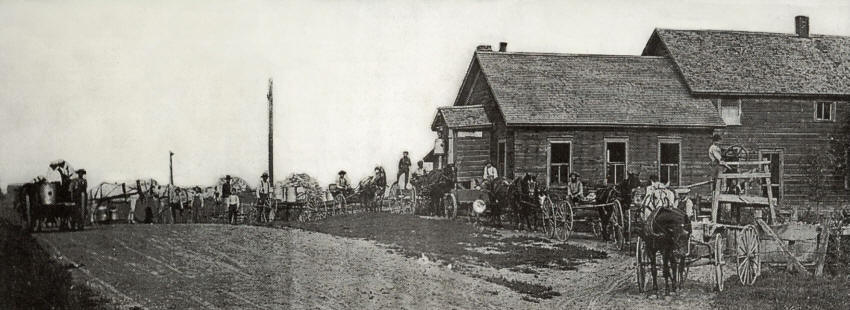
Reseburg Cheese Factory
Reseburg Township, Clark County, Wisconsin

This turn of the century photograph of the Reseburg Cheese Factory came from the collection of Anita Stocker, courtesy of the Neenah Citizen.
Stocker, now a retired Neenah city employee, age 88, remembers local history rich in cheesemaking tradition. Much of her life and that of her family centered around cheesemaking.
Stocker’s grandfather, originally from Chicago, built a small factory on his father-in-law’s farm at Collins near Brillion. There began the family’s link to cheese. Her father Otto Sommer and a cousin founded the Reseburg Cheese Factory five miles southeast of Thorp. Stocker was born there in 1907.
In those days the family living quarters – a kitchen, dining room and tiny bedroom, was located between the factory and the curing room. She remembers men taking cheese through her mother’s kitchen to the curing room.
Near the factory was a small crossroads community that included a school, general store, post office, blacksmith shop and tavern. Stocker recalls that at age five or six she walked to the tavern with a small pail for cold beer for the men in the factory. Cheesemaking was hot work.
Farmers kept milk from the evening’s milking in water tanks. These were cooled by windmills. The next day after the morning’s milking, they took all their milk to the cheese factories.
At the intake it was weight and tested for butterfat content. The higher the fat content the more the farmers were paid.
There were several steps in cheesemaking. The milk had to be thickened, heated and stored. As curds began to form and mat together, they were cut, turned and salted. Finally, they were packed in wooden hoops and covered. The hoops were put into a press and pressed until all the whey ran out. Then they were taken to the curing room.
After curing, most of the cheese was shipped to Green Bay. The whey or liquid left after cheesemaking was run through a separator. The cream that was extracted was sent to a creamery. Some of the remaining whey was put outside in tanks. Farmers took it for pig feed. The balance was drained into ditches.
The whole family worked in the factory. There was also a hired man or girl. The word was hard and had to be done daily, even on holidays. Stocker recalled watching holiday-goers pass the factory on the Fourth of July and wishing she had the day off. Her father admonished her to hurry and finish the work by 2 p.m. When the cleaning was done, the family went into Thorp for the fair.
Because cheesemaking was so difficult, Stocker swore she’d never marry a cheesemaker, but she did. Walter was from Dale. He learned cheesemaking while working at a near Gillingham Corners outside Neenah.
The Stockers bought the family cheese factory after they married. The Sockers’ factory burned down in 1929. Walter then ran a factory south of Cadott for two years. Next he went to work for Blue Moon, first in Thorp, then in Erie, Illinois.
The last cheese factory in the family was the one the Stockers owned in Iowa. There they made butter as well as cheese. The Stockers sold the factory and returned to Wisconsin. About 1944 they settled in Neenah. Walter went to work for Wisconsin Tissue Mills and remained there until he died.
Stocker went to night school for two years to learn typing and shorthand. She worked in the Jandrey’s Department Store office for two years. Her last job was with the City of Neenah. She started in the treasurer’s office and later moved upstairs to the finance department. After working under five mayors, she retired in 1973. Stocker and her her husband had two children. Their son was killed in a car accident in the mid-1940’s. Her daughter Betty has five children. Now there are also eight great-grandchildren.
Stocker cherishes her memories recorded in a written history and photographs. Some of her photo date almost from the turn of the 20th century. Many were taken and developed by her father who was also a photographer. One of Stocker’s prize photographs show the Reseburg factory in 1906 or 1907.
|
© Every submission is protected by the Digital Millennium Copyright Act of 1998.
Show your appreciation of this freely provided information by not copying it to any other site without our permission.
Become a Clark County History Buff
|
A site created and
maintained by the Clark County History Buffs
Webmasters: Leon Konieczny, Tanya Paschke, Janet & Stan Schwarze, James W. Sternitzky,
|